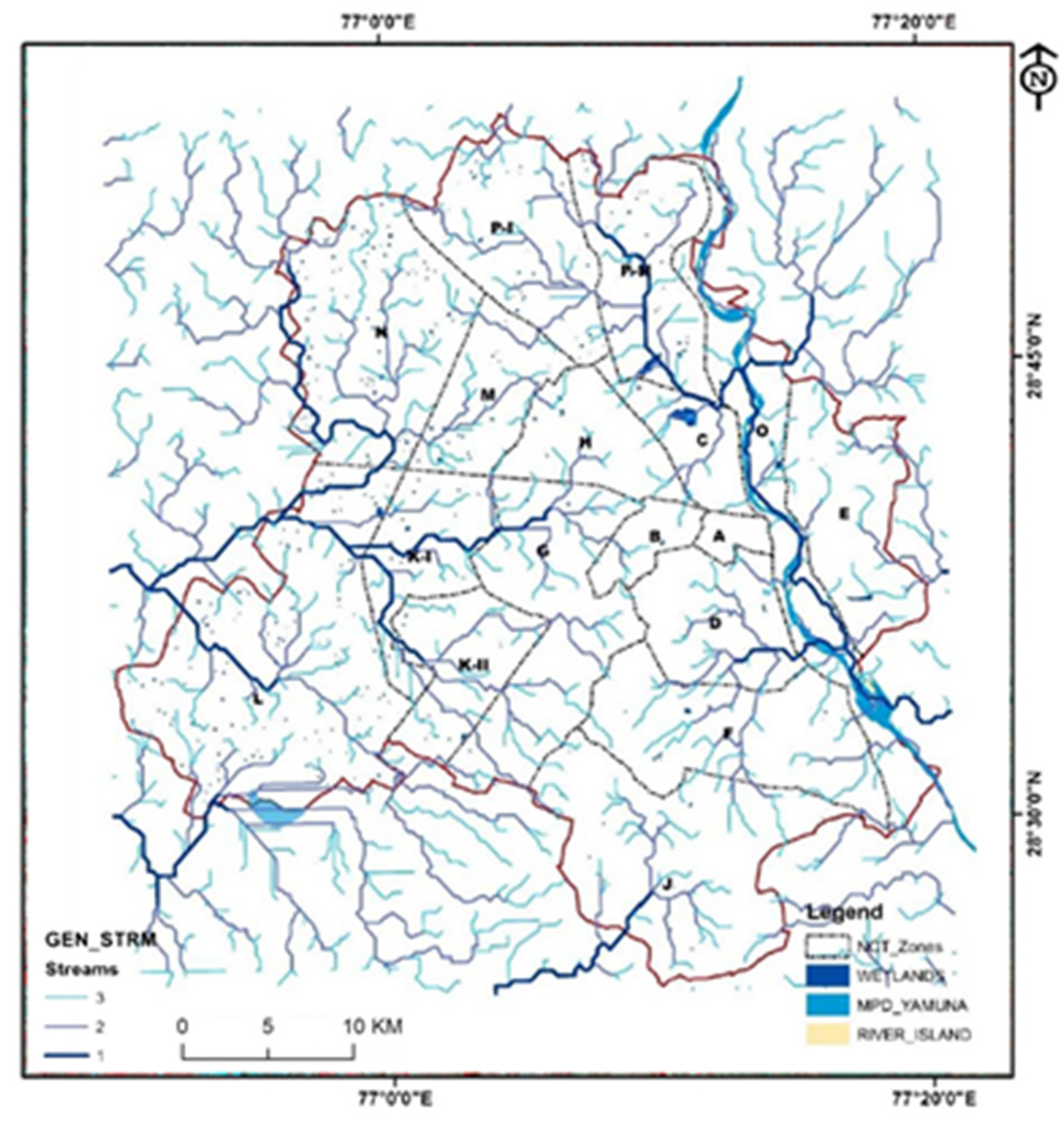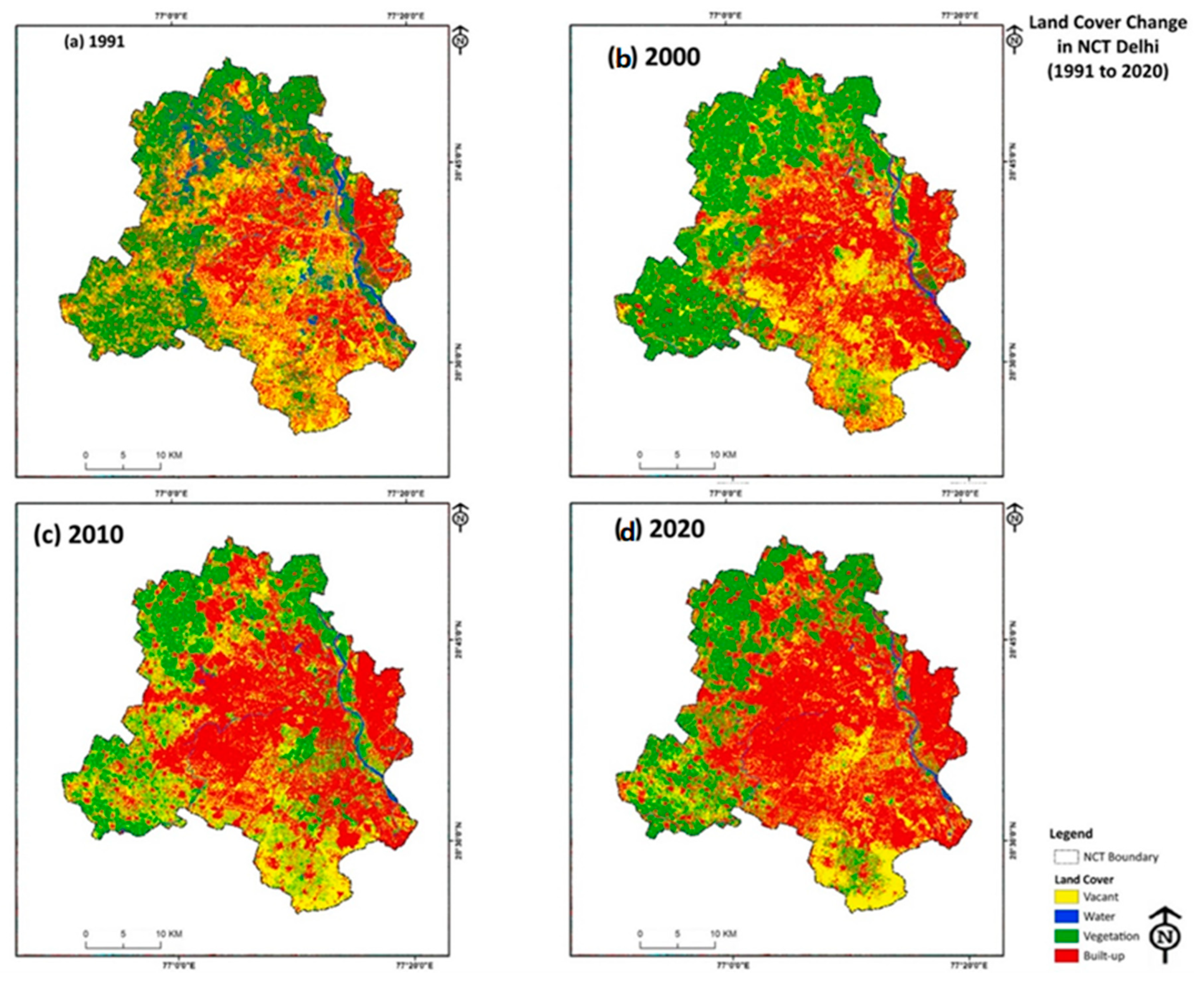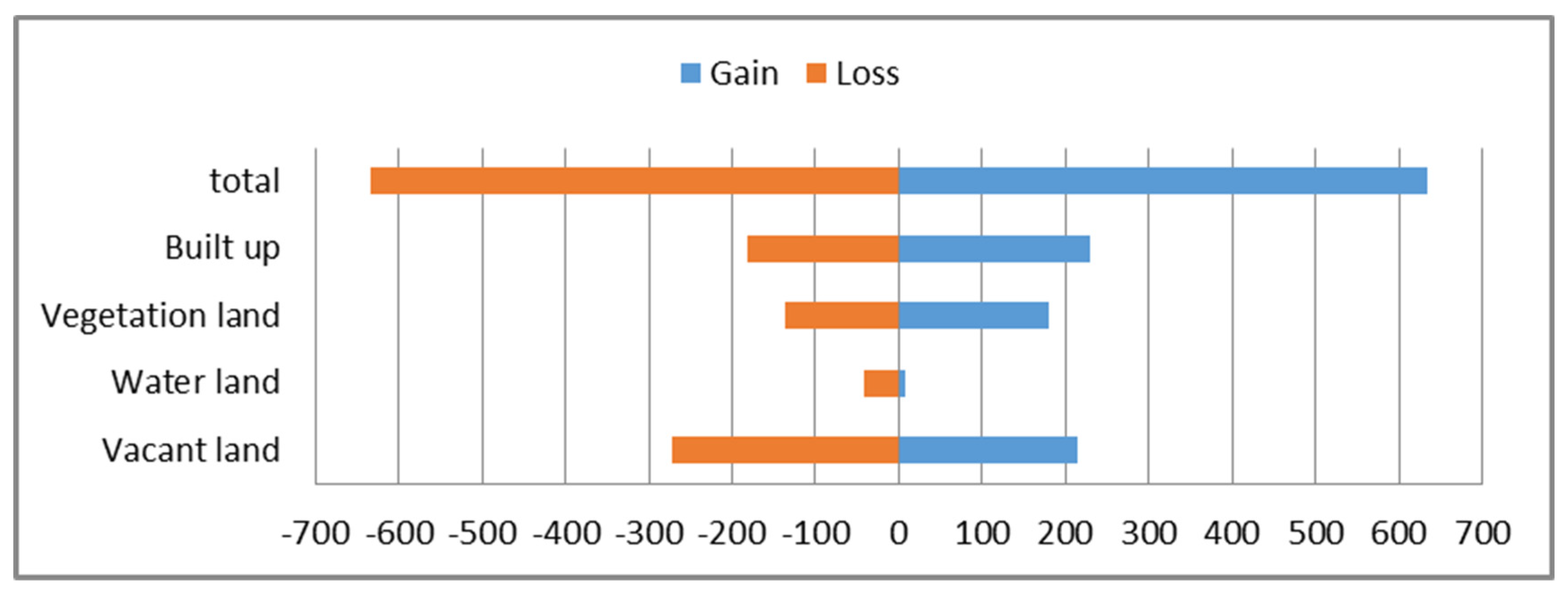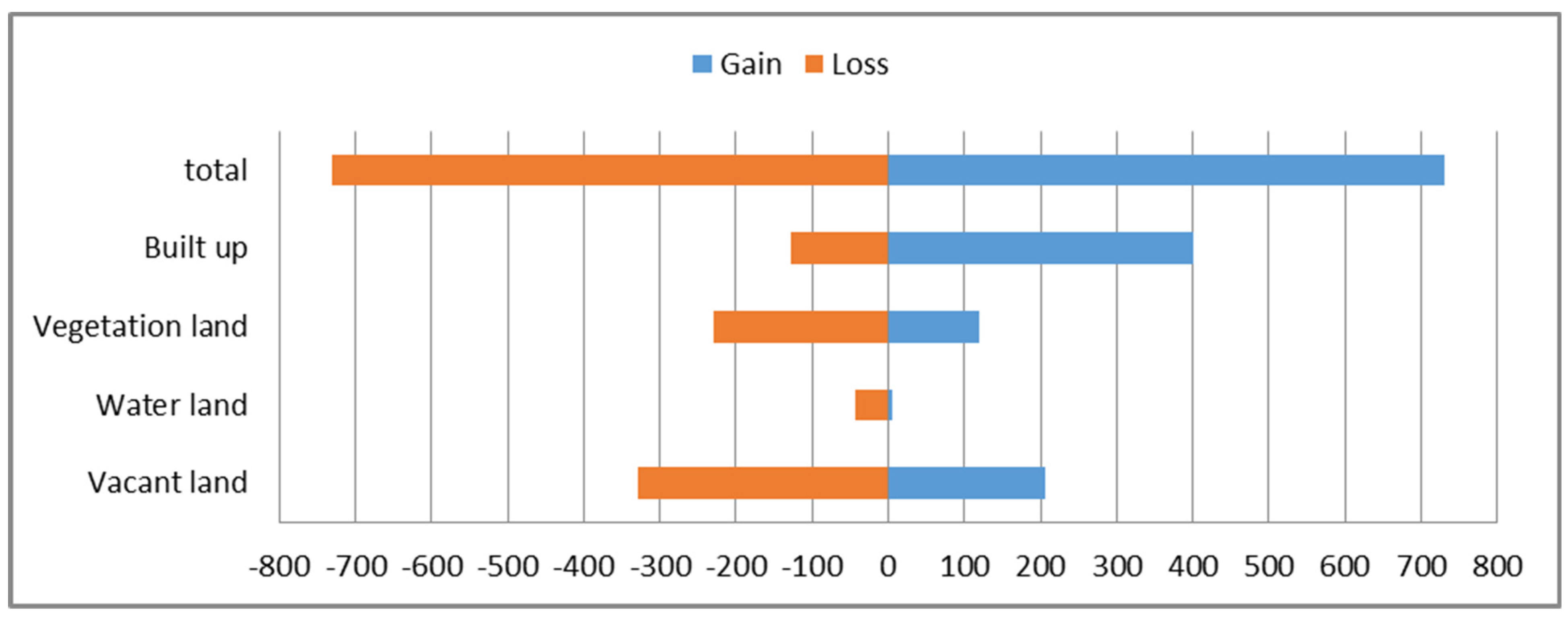Changes, Trends and Status of Land Use
The land use change maps have derived from image classification in NCT Delhi from 1991 to 2020 as shown in
Figure 3. The analysis process has performed by a post-classification detection method, a cross-tabulated matrix statistical analysis has been conducted: built-up (52.95%) land use type is the largest land type followed by vacant land (24.73%), vegetation land (21.39%) and water bodies (0.92%) in the NCT Delhi based on analysis as shown in
Figure 3,
Figure 4 and
Table 4. Built-up land use type has increased and water bodies’ land use type has decreased in last 30 years. Built-up land use is distributed evenly in the central part of the city and spreading in an outward direction and vegetation, open land uses are distributed in the periphery of the city.
In all the periods, the extent of vegetation, vacant areas, and water bodies decreased because these areas are converted into built-up land use types. From 1991 to 2020, the built-up land use area increased by 271.18 km
2. In the decades 1991–2000, 2000–2010, 2010–2020, and 1991–2020, the built-up area is increasing at rates of 5.47, 11.19, 10.99, and 27.11 km
2/year, respectively. The extent of water bodies has decreased by 37.51 km
2 and decreasing rates in decades 1991–2000, 2000–2010, 2010–2020, and 1991–2020 are 3.73, 0.24, 0.15, and 1.29 km
2/year, respectively. The extent of vegetation land use has decreased by 110.26 km
2 and in decades, 1991–2000, 2000–2010, 2010–2020 and 1991–2020 vegetation is decreasing at rates of 4.77, 12.77, 2.54, and 11.02 km
2/year, respectively. The extent of vacant land use has decreased by 123.39 km
2 and in decades 1991–2000, 2000–2010, 2010–2020 and 1991–2020 vacant land is decreasing at rates of 6.51, 1.82, 8.29, and 12.33 km
2/year, respectively shown in
Table 4 and
Figure 4. Built-up land use is increasing due to the expansion of urban areas and towns in NCT Delhi.
Decadal-wise maps as shown in
Figure 3 are prepared. Cross-tabulation matrices are produced with the help of a pivot table that shows the area of the landscape for each combination of categories in decades as shown in
Table 5,
Table 6,
Table 7 and
Table 8. Firstly, there is a need to analyze the matrices shown in
Table 5,
Table 6,
Table 7 and
Table 8 for examining the total column and the total row for showing the largest land use type which is built up in all three decades. Further, there is a need to examine the diagonal entries in tables. Diagonal entries are used for finding gains and losses as shown in
Table 5,
Table 6,
Table 7 and
Table 8. These tables give additional information for concerning gain, loss, persistence, and swap.
Above matrix shown in
Table 5 has been prepared for showing the land use changes from 1991 to 2000. The total land uses area has been identified for 1991 and 2000. Further diagonal entries are identified and highlighted in the table. For finding gain and loss, there is a need to subtract that particular land use type’s diagonal entry from the total of that particular land use type such as loss in vacant land is 272.96 km
2 (490.20 − 217.24= 272.96 km
2) and gain in vacant land is 214.33 km
2 (413.57 − 217.24 = 214.33 km
2), loss in water land is 41.71 km
2 (51.22 − 9.51 = 41.71 km
2) and gain in water land is 8.17 km
2(17.68 − 9.51 = 8.17 km
2), loss in vegetation land is 137.33 km
2 (427.47 − 290.14 = 137.33 km
2) and gain in vegetation land is 180.27 km
2 (470.41 − 290 = 180.27 km
2). Finally, the loss in built-up land is 181.42 km
2 (514.11 − 332.69 = 181.42 km
2), and the gain in built-up land is 230.66 km
2 (563.35 − 332.69 = 230.66 km
2). The loss and gain of land use have been presented in
Figure 5 for the 1991-2000 decade.
Above matrix as shown in
Table 6 has been prepared for showing the land use changes from 2000 to 2010. The total land uses area has been identified for 2000 and 2010. Further diagonal entries are identified and highlighted in the table. For finding gain and loss, there is a need to subtract that particular land use type’s diagonal entry from the total of that particular land use type such as loss in vacant land is 243.96 km
2 (431.57 − 187.61 = 243.96 km
2) and gain in vacant land is 262.19 km
2 (449.80 − 187.61 =262.19 km
2), loss in water land is 9.02 km
2 (17.68 − 8.66 =9.02 km
2) and gain in water land is 6.56 km
2 (15.22 − 8.66 =6.56 km
2), loss in vegetation land is 240.03 km
2 (470.41 − 230.38 = 240.03 km
2) and gain in vegetation land is 112.27 km
2 (342.65 − 230.38 = 112.27 km
2). Finally, the loss in built-up land is 123.13 km
2 (563.35 − 440.22 = 123.13 km
2), and the gain in built-up land is 235.12 km
2 (675.34 − 440.22 = 235.12 km
2). The loss and gain of land use have been presented in
Figure 6 for the 2000–2010 decade.
Above matrix as shown in
Table 7 has been prepared for showing the land use changes from 2010 to 2020. The total land uses area has been identified for 2010 and 2020. Further diagonal entries are identified and highlighted in the table. For finding gain and loss, there is a need to subtract that particular land use type’s diagonal entry from the total of that particular land use type such as loss in vacant land is 254.99 km
2 (449.80 − 194.81 = 254.99 km
2) and gain in vacant land is 172.00 km
2 (366.81 − 194.81 =172.00 km
2), loss in water land is 6.77 km
2 (15.22 − 8.45 =6.77 km
2) and gain in water land is 5.26 km
2 (13.71 − 8.45 = 5.26 km
2), loss in vegetation land is 139.52 km
2 (342.52 − 203.13 = 139.52 km
2) and gain in vegetation land is 114.08 km
2 (317.21 − 203.13 = 114.08 km
2). Finally, the loss in built-up land is 95.90 km
2 (675.34 − 579.44 = 95.90 km
2), and the gain in built-up land is 205.85 km
2 (785.29 − 579.44 = 205.85 km2). The loss and gain of land use have been presented in
Figure 7 for the 2010–2020 decade.
Above matrix as shown in
Table 8 has been prepared for showing the land use changes from 1991 to 2020. The total land uses area has been identified for 1991 and 2020. Further diagonal entries are identified and highlighted in the table. For finding gain and loss, there is a need to subtract that particular land use type’s diagonal entry from the total of that particular land use type such as loss in vacant land is 329.75 km
2 (490.20 − 160.45 = 329.75 km
2) and gain in vacant land is 206.36 km
2 (366.81 − 160.45 = 206.36 km
2), loss in water land is 43.33 km
2 (51.22 − 7.89 = 43.33 km
2) and gain in water land is 5.82 km
2 (51.22 − 7.89 = 5.82 km
2), loss in vegetation land is 229.09 km
2 (427.47 − 198.38 = 229.09 km
2) and gain in vegetation land is 118.83 km
2 (317.21 – 198.38 = 118.83 km
2). Finally, the loss in built-up land is 128.74 km
2 (514.11 − 385.37 = 128.74 km
2), and the gain in built-up land is 399.92 km
2 (785.29 − 385.37 = 399.92 km
2). The loss and gain of land use have been presented in
Figure 8 for the 1991-2020 decade. This result presents that the built-up has the largest gain 399.92 km
2 of the area and vacant land has the largest loss 329.75 km
2 of the area from the 1991 to 2020 timeline.
Further, the discussed methods have been used to analyze the land use changes, trends, status, and directions in NCT Delhi for 1991–2000, 2000–2010, 2010–2020, and 1991–2020. In
Table 9 and
Table 10, the net change (Nc), total change (Tc), and index(P) for individual land use type and net change (Ncs), total change (Tcs), and index (Ps) for the whole region are described, respectively.
Table 9 and
Table 10 show the landuse change trends decadal-wise for every land use type. In the decade 1991–2000 as shown in
Table 9 and
Table 10, the total change for the whole region is 42.71% which shows the conversion of land use types accounting for 42.71% of the whole area. This resulted in a net change of 6.21%, in this period individual land use type shows that built-up and vegetation land use types have been expanded and water bodies, and vacant land use types have been shrunk. In this period, the Ps index shows a 0.145 value which indicates changes are balanced, two-way transition, and positive changes. Based on values of land use types, vacant land use type shows balanced, two-way transition and negative changes; water land use type shows imbalanced, one-way transition and negative change; vegetation land use type shows balanced, two-way transition and positive change; and built-up land use shows balanced, two-way transition and positive change. This change in trend shows that water body land use type is decreasing and converted into vegetation and built-up land use types.
Further, in the decade 2000–2010 as shown in
Table 9 and
Table 10, total change is 41.54% and net change is 8.78% for the whole region. In this timeline, individual land types, built-up, and vacant land types are expanding and vegetation and water bodies are shrinking. Vacant land is expanding at a slow rate. Ps index is 0.21 slightly increased, which presents that the change is balanced, with two-way transition and positive changes. P values for vacant, water, and built up is increased but for vegetation is decreased. Based on P values of land use types, vacant land use type shows balanced, two-way transition and positive changes; water body land use type shows balanced, two-way transition and negative changes; vegetation land use type shows quasi-balanced, two-way transition and negative changes; and built-up land use type shows quasi-balanced, two-way transition and positive changes.
In the decade, 2010–2020 as shown in
Table 9 and
Table 10, a net change is 7.41% and the total change is 33.52% for the whole region. Individual land type water bodies, vegetation, and vacant land use types are shrinking, and built-up land type is expanding. Ps index is 0.22 slightly increased, which presents the change is balanced, with two-way transition and positive changes. P values for vacant land use type are decreased but water, vegetation, and built-up are increased. Based on P values of land use types, vacant land use type shows balanced, two-way transition and negative changes; water land use type shows balanced, two-way transition and negative changes; vegetation land use type shows balanced, two-way transition and negative changes; built-up land use type shows quasi-balanced, two-way transition and positive changes. All the P values of every land use type have increased but for built-up, it has changed from 0.11 to 0.51.
In the entire period timeline 1991–2020 as shown in
Table 9 and
Table 10, individual land use types of vacant land, water bodies, and vegetation are shrinking and built-up is expanding. Water body land use type is shrinking rapidly. In this major timeline, the net change is 18.28% and the total change is 49.28% for the whole region. In the whole study, the land use change trends (P = 0.37) present quasi-balanced, two-way transition and positive changes. This value is much higher than the three periods because it is the longer period and has a higher sum of changes. The P value of the built-up (0.51) is the largest with vegetation land and vacant land use types having smaller and water land use type having the smallest.
Based on the above statistical analysis, NCT Delhi has a quasi-balanced status and trends of land use as shown in
Table 3 and
Table 10. This phenomenon is happening due to increasing built-up area due to human activities and climate changes (decreasing in surface water resources area). As per analysis, water land use type is converted into vacant land, smaller vegetation land, and built-up land use types.













